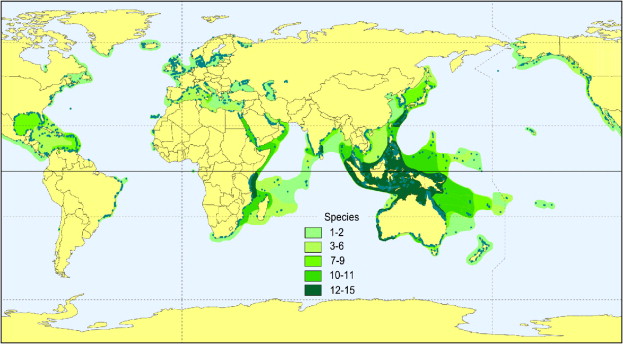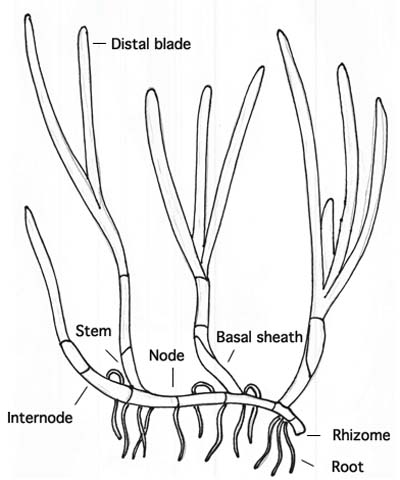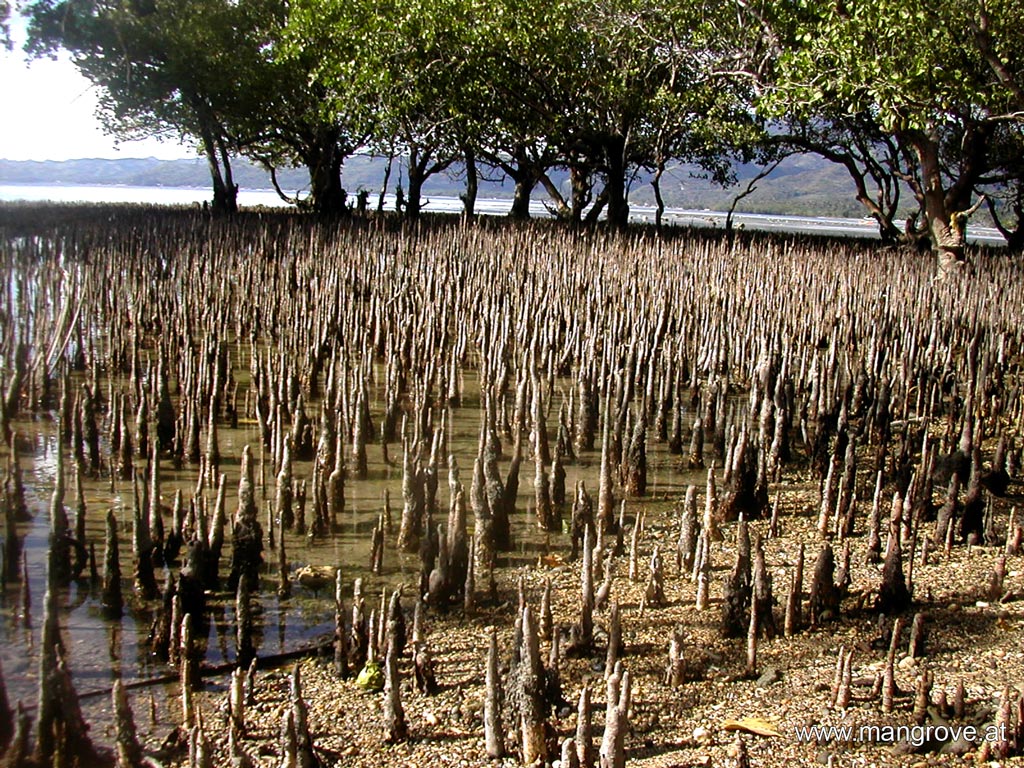Mangal communities are specialist habitats, yet have a biodiversity lower than might be expected. They are intertidal, low-energy, heterogenous environments that allow the build-up of sediment and are typically tropical, with fast-growing species dominating.for instance, Mangroves. They are coastal communities, the tropical equivalents of temperate salt marshes, and are found on 75% of tropical coastlines. Mangroves may only grow where the water is shallow enough; sediment deposition occurs; light is adequate and water temperature is above 50C.
Mangroves facilitate sedimentation by reducing water velocity and retaining deposited particles; vegetation succession establishes itself over time, and the physiography of the system is dominated by creek networks, and provide the routes through which water floods and ebbs. The aerial shoots and branches of mangroves are essentially terrestrial habitats.
Succession: The orderly process of change over time in a community, which cause changes in the physical environment and allow another community to be established. The gradual improvement of an environment's hospitability.
Zonation: The arrangement or patterning of plant communities or ecosystems into parallel or subparallel bands in response to change in some environmental factor. An area with a dominant climax community.
Mangrove Species
All Mangrove species are capable of inhabiting the intertidal zone, but some are better adapted to the more interchangable conditions. White mangrove (Laguncularia racemose) and Buttonwood (Conocarpus erectus) are both terrestrial species, housing birds, bats and other mammals. E.g. the long-tongued nectar bat, a key pollinator for the mangal community. The marine-adapted species are the Red mangrove (Rhizophora mangle) and Black mangrove (Avicennia germinans).

Mangroves are fast-growing, which means the are has lots of particulate organic matter (POM) - this infers a high bacteria rate. No benthic algae can grow as the mangrove roots block the light. Anoxic sediment thereby develops, containing sulphide, and most anoxic sediments are found in the seaward zone where the Red mangroves grow. Mangroves exhibit discreet species settlement and won't outcompete and replace each other over time - hence it is thought mangroves align through zonation, not succession.
Tidal regime
As landward areas dry out, high salinity and desiccation occurs; salt crystals can form with evaporation on the mangrove leaves; rain and tide are required to wash it away before it damages the plants by impacting their osmotic movements. This process is called tidal flushing, and it is also useful for removing the sulphide that builds up in anoxic sediments. Tidal immersion hydrates and provides nutrients too. Early studies indicated 50% of net plant production of these areas was exported by tidal flushing - these systems can therefore be considered significant carbon supplies to the continental shelf.
Adaptations to anoxic sediments
Colonisation by plants stabilises the sediment, but tidal immersion limits oxygen exchange; high detrital input from plants leads to high bacterial mineralisation rates, leading to anoxic sediment. For this reason, Mangroves have pneumatophores, negatively geostrophic roots up to 3m in length - these aerial roots allow the direct gas exchange of oxygen in to the roots.
Lenticels are pores in the roots which allow gas exchange but not water and solutes, enabling oxygen to be transported through channels in the aerenchyma tissues, keeping out salts. they are found n pneumatophores and prop roots.
Avicennia spp., takes in salts through the plant roots, which it transports to the leaves through the plant sap. The sap concentrates the salt at 3-4 SU, and secretes it out through salt glands and the leaves. The root membranes are semi-permeable, so exclude most salt ions to limit uptake.
Non-salt secretors such as Rhizophora and Bruguiera spp., are extremely tolerant of salt storage through ultra-filtration, which is a high-energy process but very successful. The system is complex but radial filtration occurs in the roots, where an ion pumps in the xylem and salt is stored in ion-saturated filter cells that are sealed off with a suberin coating. These cells are lost when the leaves shed and are pushed back down the plant by growth.
Mangrove Reproduction
Mangroves have viviparous seeds that germinate on the parent plant: vivipary describes germination within the parent, and this occurs within the Rhizophora spp., and Bruguiera spp. The embryo grows out through the seed coat, giving it a head start for growth. When the seed falls from the plant it immediately begins to compete with its parents, so the head-start is incredibly important. Cryptovivary occurs within the Avicennia spp., where the growth does occur but is not visible to an outside observer. The embryo here only grows out through the seed coat and not the fruit wall before it splits open.
If the seed drops during high tide, it will be taken with the currents and deposited elsewhere, where competition is likely to be lower, but the environment may be less suitable. If the seed is dropped during low tide, the habitat is guaranteed to be suitable, but competition will be higher.
Mangal Community Fauna
There are several key indicator species within mangal communities. For instance, the Mangrove oyster (Saccostrea cucullata), snails such as Cerithidea obtuse, and barnacles such as Littoraria carnifera. Decapods including the Fiddler Crab (Uca chlorophthalamus) are also present. Chelicerates include spiders, mites and horseshoe crabs, creatures that evolved 4 million years ago unchanged. Fish present include the teleosts such as Mullet spp., (Mucilidae) and the cardinal fish - juveniles in mangroves that breed on corals. The giant mudskipper is also a key organism (Periopthalamodon schlosseri), alongside the Archerfish (Toxotes jaculatrix), which spouts water out at invertebrates to knock them off their branches. Mammals and birds include the long-tongued nectar bat, Golden Plover, Little Egret and Striated heron. One mangrove gastropod, the Cerithidea decollata, migrates vertically throughout the day, as it forages on the mud surface during low tide before retreating back on to the trees well before the incoming high tide. Their irregular behaviours and migration patterns however mean their actions cannot be explained by internal clocks, and direct cues seem to be based off of local conditions, rather than a universal genetic tendancy.

Human uses for Mangrove species
The Rhizophora mangle is used for timber, paper pulp, cattle fodder, tobacco substitute, wine, fishing line and medicinal purposes. They grow up to 30m tall, and may be easily cultivated. The Avicennia germinans are not useful for timber, but are a soap substitute, and the bark may be used in tanning, and its flowers are important for the local honey industry.
Sources: My own lecture notes.
Vertical migrations of the mangrove snail Cerithidea decollata (L.)
(Potamididae) through a synodic month
Marco Vannini a,*, Cecilia Coffa b
, Elisabetta Lori c
, Sara Fratini a. 2008. Estuarine, Coastal and Shelf Science.




















